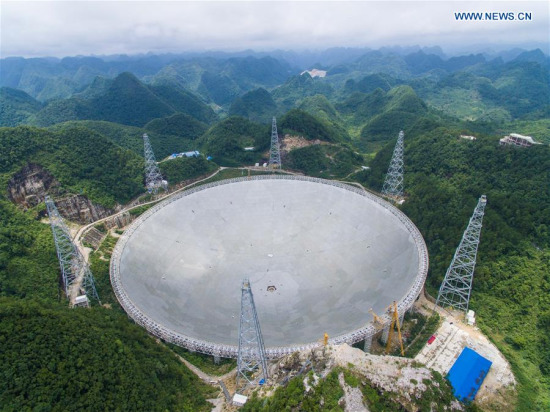
The aerial photo taken on July 3, 2016 shows the Five-hundred-meter Aperture Spherical Telescope (FAST) in Pingtang County, southwest China's Guizhou Province. (Xinhua/Liu Xu)
Installation was completed on the world's largest radio telescope on Sunday morning as the last of 4,450 panels was fitted into the center of the big dish.
Hoisting of the last triangular panel to the reflector, which is the size of 30 football fields, began at 10:47 a.m. and lasted about an hour. It was a landmark step for the telescope's planned launch of operations in September.
About 300 people, including builders, experts, science fiction enthusiasts and reporters, witnessed the installation at a karst valley in Pingtang County in the southwestern province of Guizhou.
"The telescope is of great significance for humans to explore the universe and extraterrestrial civilizations," said Liu Cixin, a renowned science fiction writer, at the site.
"I hope scientists can make epoch-making discoveries," said Liu, who won the 2015 Hugo Award for Best Novel.
Scientists will then begin debugging and trial observation of the Five-hundred-meter Aperture Spherical Telescope (FAST), said Zheng Xiaonian, deputy head of the National Astronomical Observation (NAO) under the Chinese Academy of Sciences, which built the telescope.
The project has the potential to search for more strange objects to better understand the origin of the universe and boost the global hunt for extraterrestrial life, said Zheng.
Zheng said the radio telescope will be the global leader for the next 10 to 20 years.
In the first two or three years after its completion, the telescope will undergo further adjustment, and during that period Chinese scientists will use it for early-stage research. After that, it will be open to scientists worldwide, said Peng Bo, director of the NAO Radio Astronomy Technology Laboratory.
Scientists can also carry out remote control and observation in other cities such as Beijing, more than 2,000 kilometers from the telescope site, said Peng.
Upon completion, the telescope will dwarf Puerto Rico's Arecibo Observatory, which is 300 meters in diameter. It will also be 10 times more sensitive than the steerable 100-meter telescope near Bonn, Germany, he said.
"Most of the technology and materials are domestically made," said Wang Qiming, chief technologist of the FAST project.
Among the 7 FAST receivers, five were domestically made and another two were co-produced by Chinese, Australian and American institutions.
Work on the 1.2-billion-yuan (180 million U.S. dollars) FAST project began in 2011.


















































